8 Herbal Remedies for Dry Skin
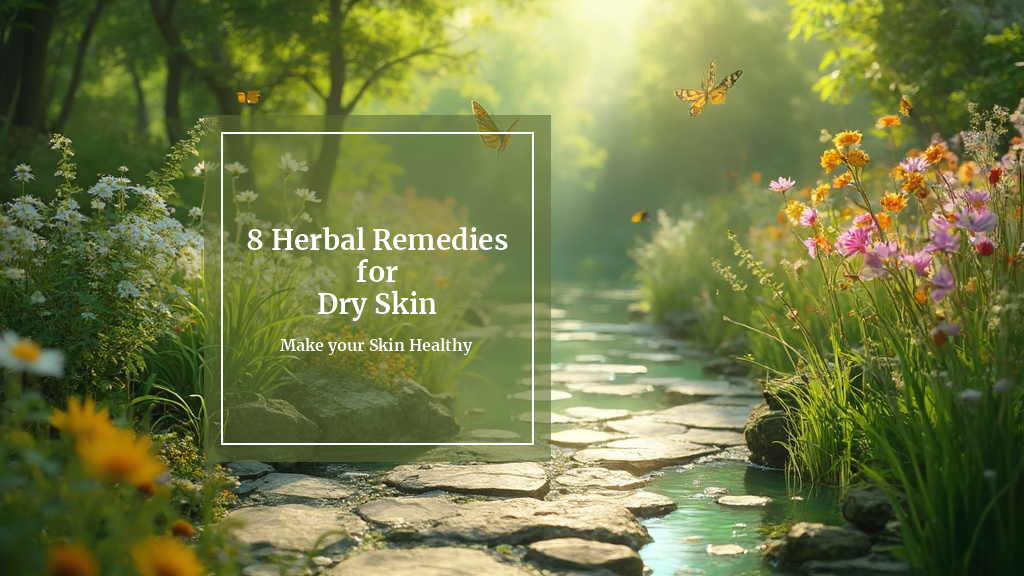
Table of Contents
- Introduction
- 1. Aloe Vera: Nature’s Moisturizer
- 2. Coconut Oil: Deep Hydration
- 3. Oatmeal: Soothing and Protective
- 4. Chamomile: Calming and Anti-inflammatory
- 5. Calendula: Healing and Nourishing
- 6. Shea Butter: Rich in Vitamins and Fatty Acids
- 7. Jojoba Oil: Balancing Skin’s Natural Oils
- 8. Honey: Natural Humectant
- Conclusion
Introduction
Dry skin is a common concern that affects millions of people worldwide. It can lead to discomfort, itching, and even more serious skin conditions if left untreated. While there are numerous over-the-counter products available, many people are turning to natural, herbal remedies for a gentler approach to skincare. These time-tested solutions not only hydrate the skin but also provide additional benefits without harsh chemicals.
In this comprehensive guide, we’ll explore eight effective herbal remedies for dry skin that have been supported by both traditional use and modern research. As we delve into these natural solutions, it’s worth noting that understanding the principles of holistic skincare is a crucial aspect of overall health and well-being. For those interested in deepening their knowledge in this area, the Naturopathy Practitioner course offers valuable insights into natural healing methods, including skincare techniques that complement these herbal remedies.
Let’s explore these natural remedies that can help you achieve healthy, hydrated skin using the power of herbs and plants.
1. Aloe Vera: Nature’s Moisturizer
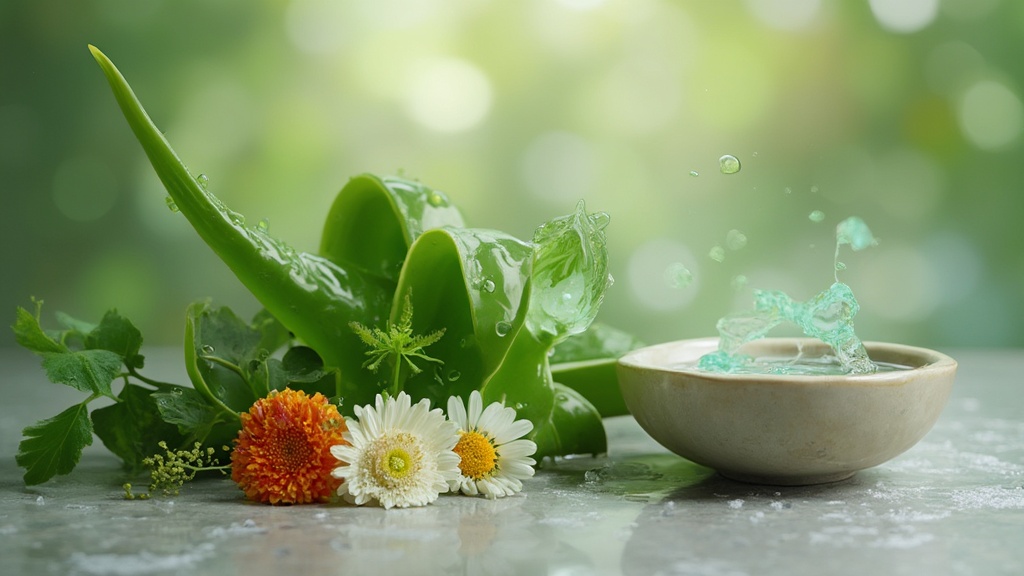
How to Use Aloe Vera for Dry Skin
Time Required: 10-15 minutes
Materials Needed: Fresh aloe vera leaf or pure aloe vera gel
Aloe vera is renowned for its moisturizing and soothing properties. Rich in vitamins, minerals, and amino acids, it’s an excellent natural remedy for dry skin. Here’s how to use it:
- If using a fresh leaf, cut it open and scoop out the gel.
- Apply a thin layer of aloe vera gel directly to clean, dry skin.
- Gently massage the gel into your skin using circular motions.
- Leave it on for 10-15 minutes or overnight for deeper hydration.
- Rinse with cool water if desired, or leave it on as a natural moisturizer.
Benefits:
- Provides immediate hydration and cooling effect
- Contains antioxidants that protect skin from environmental damage
- Has anti-inflammatory properties that can soothe irritated skin
- Promotes skin healing and may help with minor burns or sunburn
A study published in the Journal of Occupational and Environmental Medicine found that the use of aloe vera gel gloves significantly improved skin integrity and hydration in participants with occupational dry skin. This research underscores the effectiveness of aloe vera as a natural moisturizer.
For those interested in learning more about the healing properties of plants like aloe vera, the beginner’s guide to naturopathy provides an excellent introduction to natural healing principles.
2. Coconut Oil: Deep Hydration
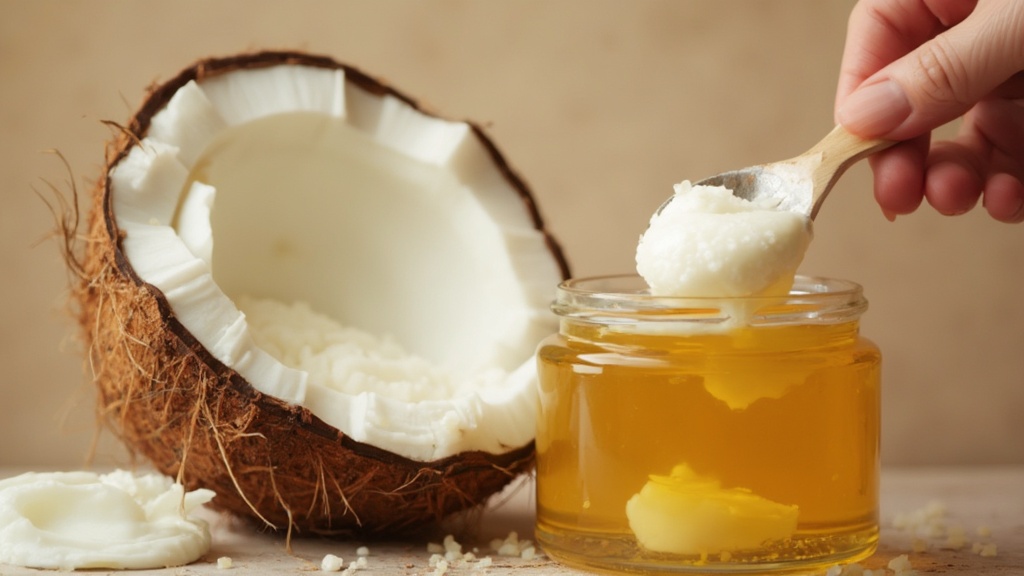
Applying Coconut Oil for Dry Skin Relief
Time Required: 5-10 minutes
Materials Needed: Virgin coconut oil
Coconut oil is a versatile natural moisturizer that’s particularly effective for dry skin. Its fatty acid content helps to nourish and protect the skin barrier. Here’s how to use it:
- Warm a small amount of coconut oil between your palms until it liquefies.
- Apply the oil to clean, slightly damp skin.
- Gently massage the oil into your skin, focusing on dry areas.
- For best results, apply before bedtime and leave on overnight.
Benefits:
- Provides deep, long-lasting hydration
- Contains lauric acid, which has antimicrobial properties
- May help reduce inflammation and protect against oxidative stress
- Can improve skin barrier function, reducing moisture loss
Coconut oil’s effectiveness in treating dry skin is supported by scientific research. A study published in the International Journal of Dermatology found that virgin coconut oil significantly improved skin hydration and increased skin surface lipid levels in patients with mild to moderate atopic dermatitis.
Understanding the principles behind natural remedies like coconut oil is a key aspect of holistic health. Those interested in exploring this further might find value in learning about naturopathy principles, practices, and benefits.
3. Oatmeal: Soothing and Protective
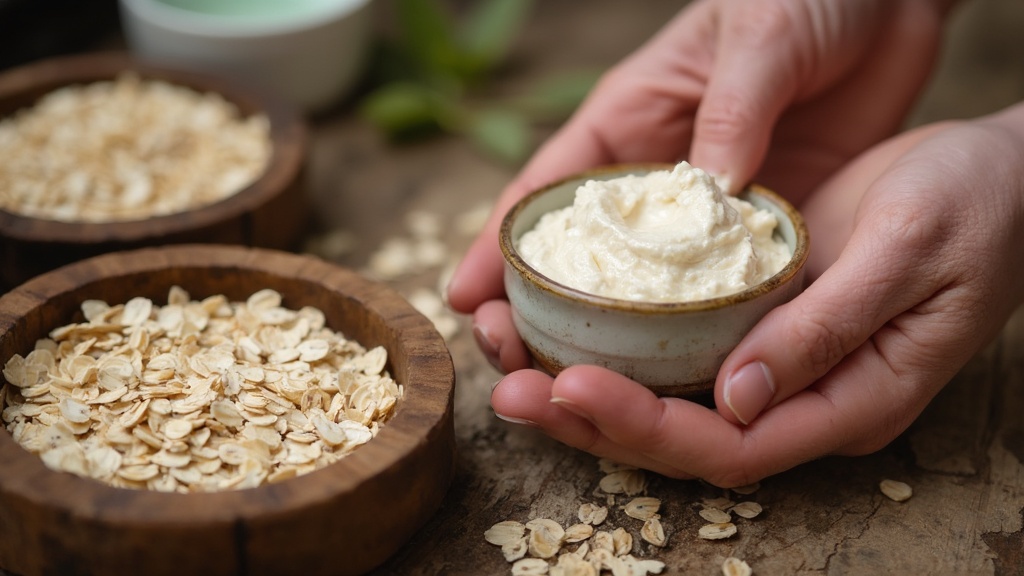
Creating an Oatmeal Bath for Dry Skin Relief
Time Required: 15-20 minutes
Materials Needed: Colloidal oatmeal or finely ground regular oats, bathtub
Oatmeal has been used for centuries to soothe and protect dry, irritated skin. Its compounds, including avenanthramides, have anti-inflammatory and anti-itching properties. Here’s how to use oatmeal for dry skin:
- Fill your bathtub with warm (not hot) water.
- Add 1 cup of colloidal oatmeal or finely ground oats to the water.
- Mix the oatmeal into the water until it’s evenly distributed.
- Soak in the oatmeal bath for 15-20 minutes.
- Gently pat your skin dry with a soft towel after the bath.
Benefits:
- Forms a protective barrier on the skin, locking in moisture
- Contains compounds that reduce inflammation and itching
- Helps balance skin pH, which can be beneficial for dry skin conditions
- Gently cleanses without stripping natural oils
The effectiveness of oatmeal for dry skin is well-documented. The American Academy of Dermatology recommends oatmeal baths as a home remedy for relieving dry, itchy skin, particularly for conditions like eczema.
For those interested in exploring more natural treatments for various skin conditions, the article on 10 naturopathic treatments for specific health conditions offers additional insights into holistic approaches to skincare and overall health.
4. Chamomile: Calming and Anti-inflammatory

Using Chamomile for Dry, Irritated Skin
Time Required: 10-15 minutes (preparation) + 15-20 minutes (application)
Materials Needed: Dried chamomile flowers or chamomile tea bags, hot water, clean cloth
Chamomile is known for its calming and anti-inflammatory properties, making it an excellent remedy for dry, irritated skin. Here’s how to harness its benefits:
- Steep 2-3 tablespoons of dried chamomile flowers or 2-3 chamomile tea bags in hot water for 10-15 minutes.
- Allow the infusion to cool until it’s comfortably warm.
- Soak a clean cloth in the chamomile tea.
- Apply the soaked cloth to affected areas as a compress for 15-20 minutes.
- Repeat 2-3 times daily as needed.
Benefits:
- Contains alpha-bisabolol, which has anti-inflammatory and anti-irritant properties
- Helps soothe dry, itchy skin and reduce redness
- May accelerate healing of dry, damaged skin
- Provides gentle hydration without clogging pores
Research published in the Journal of Clinical and Aesthetic Dermatology has shown that chamomile extracts can significantly improve skin hydration and reduce transepidermal water loss, making it an effective natural treatment for dry skin conditions.
Understanding the healing properties of herbs like chamomile is just one aspect of naturopathic medicine. For those interested in a deeper dive into this field, exploring the career opportunities in naturopathy can provide valuable insights into how these natural remedies are applied in professional settings.
5. Calendula: Healing and Nourishing
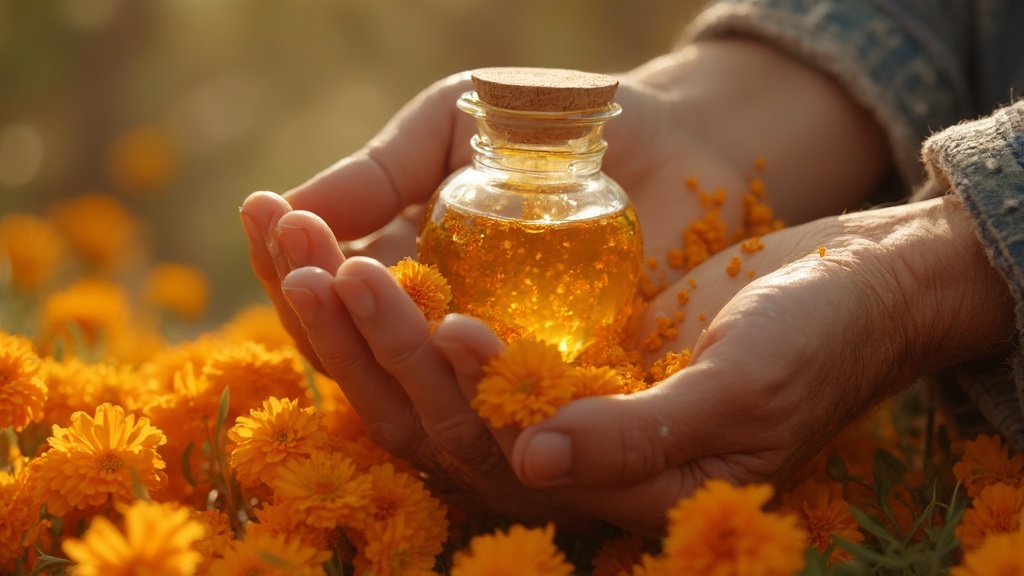
Preparing and Applying Calendula for Dry Skin
Time Required: 5-10 minutes (application), 2-4 weeks (for oil preparation)
Materials Needed: Calendula flowers, carrier oil (e.g., olive oil), glass jar
Calendula, also known as marigold, is renowned for its skin-healing and nourishing properties. Here’s how to create and use a calendula-infused oil for dry skin:
- Fill a clean glass jar with dried calendula flowers.
- Cover the flowers completely with a carrier oil like olive oil.
- Seal the jar and place it in a sunny spot for 2-4 weeks, shaking daily.
- Strain the oil and store it in a dark glass bottle.
- To use, apply a small amount of the infused oil to clean, dry skin.
- Gently massage the oil into the skin, focusing on dry or irritated areas.
Benefits:
- Contains triterpenoids that help skin retain moisture
- Offers anti-inflammatory properties that can soothe irritated skin
- Promotes skin healing and may help with minor wounds or skin damage
- Rich in antioxidants that protect skin from environmental stressors
The efficacy of calendula for skin health is well-documented. A study published in the Journal of Clinical and Aesthetic Dermatology found that calendula-based creams significantly improved skin hydration and elasticity in participants with dry skin.
For more information on the benefits of calendula and other herbal remedies, visit Herbal Remedies Advice. This resource provides comprehensive insights into the use of calendula for various skin conditions.
Understanding the principles behind herbal remedies like calendula is a key aspect of naturopathic medicine. For those interested in exploring this field further, learning about the core principles of naturopathy can provide valuable context forhow to integrate these natural remedies into a holistic approach to health and wellness.
6. Shea Butter: Rich in Vitamins and Fatty Acids
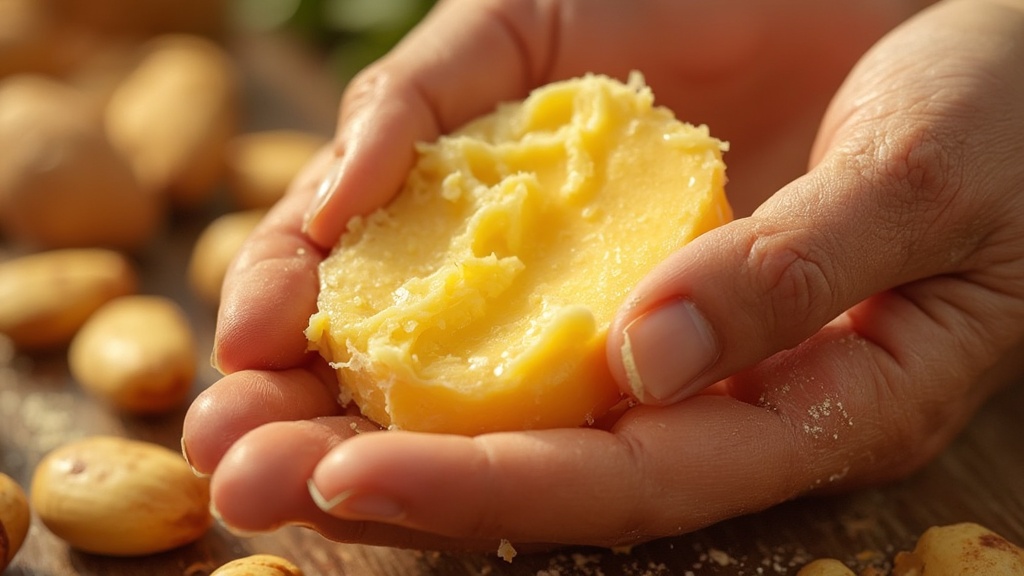
Using Shea Butter for Deep Skin Nourishment
Time Required: 5-10 minutes
Materials Needed: Raw, unrefined shea butter
Shea butter is a natural fat extracted from the nuts of the shea tree. It’s incredibly rich in vitamins and fatty acids, making it an excellent moisturizer for dry skin. Here’s how to use it:
- Scoop a small amount of raw shea butter into your palm.
- Rub your hands together to warm and soften the butter.
- Apply the melted shea butter to clean, dry skin.
- Gently massage it into your skin, focusing on particularly dry areas.
- For best results, apply before bedtime and leave on overnight.
Benefits:
- Contains high concentrations of fatty acids and vitamins
- Provides deep, long-lasting hydration
- Has anti-inflammatory properties that can soothe irritated skin
- May help improve skin elasticity and reduce the appearance of fine lines
Research published in the Journal of Oleo Science has shown that shea butter can significantly improve skin hydration and barrier function, making it an effective natural treatment for dry skin conditions.
Understanding the benefits of natural ingredients like shea butter is just one aspect of a holistic approach to skincare. For those interested in exploring more about natural healing methods, the Introduction to Naturopathy course offers valuable insights into the principles of natural medicine and its applications in skincare and overall health.
7. Jojoba Oil: Balancing Skin’s Natural Oils
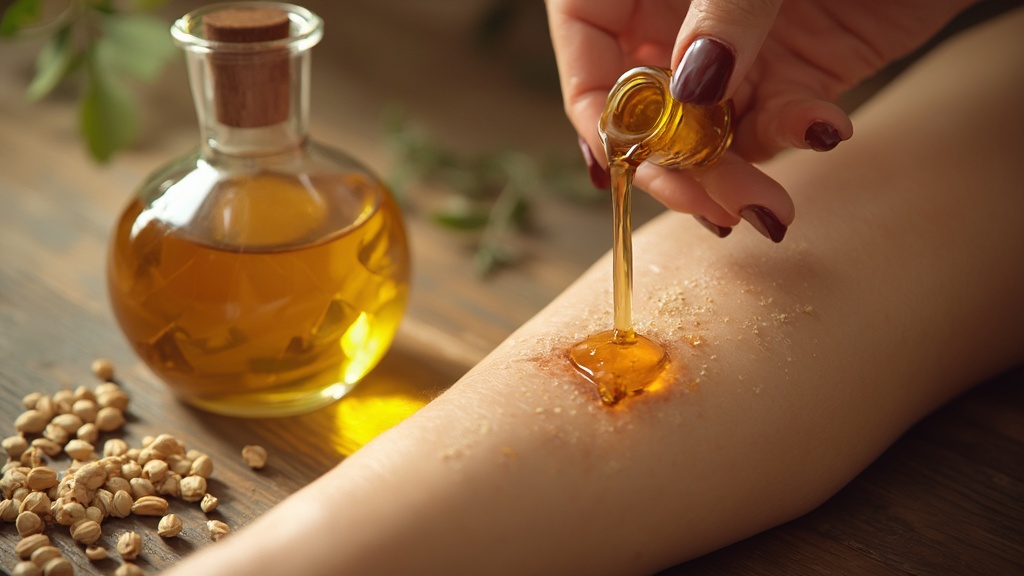
Applying Jojoba Oil for Skin Balance
Time Required: 5-10 minutes
Materials Needed: Pure jojoba oil
Jojoba oil is unique among natural oils because its composition closely resembles human sebum, making it an excellent choice for balancing skin’s natural oils. Here’s how to use it:
- Cleanse your face with a gentle, non-drying cleanser.
- While your skin is still slightly damp, place a few drops of jojoba oil in your palm.
- Gently pat and press the oil into your skin, rather than rubbing.
- Focus on areas that are particularly dry or prone to oiliness.
- Use morning and night, or as needed throughout the day.
Benefits:
- Mimics skin’s natural sebum, helping to balance oil production
- Non-comedogenic, meaning it won’t clog pores
- Contains vitamin E and antioxidants that protect skin from environmental damage
- Can help reduce the appearance of fine lines and wrinkles
A study published in the Journal of Ethnopharmacology found that jojoba oil has anti-inflammatory properties and can significantly improve skin hydration, making it an effective natural treatment for dry skin and various dermatological conditions.
For those interested in learning more about how natural oils like jojoba can be integrated into a holistic skincare routine, the comparison between naturopathy and conventional medicine provides valuable insights into different approaches to skin health.
8. Honey: Natural Humectant
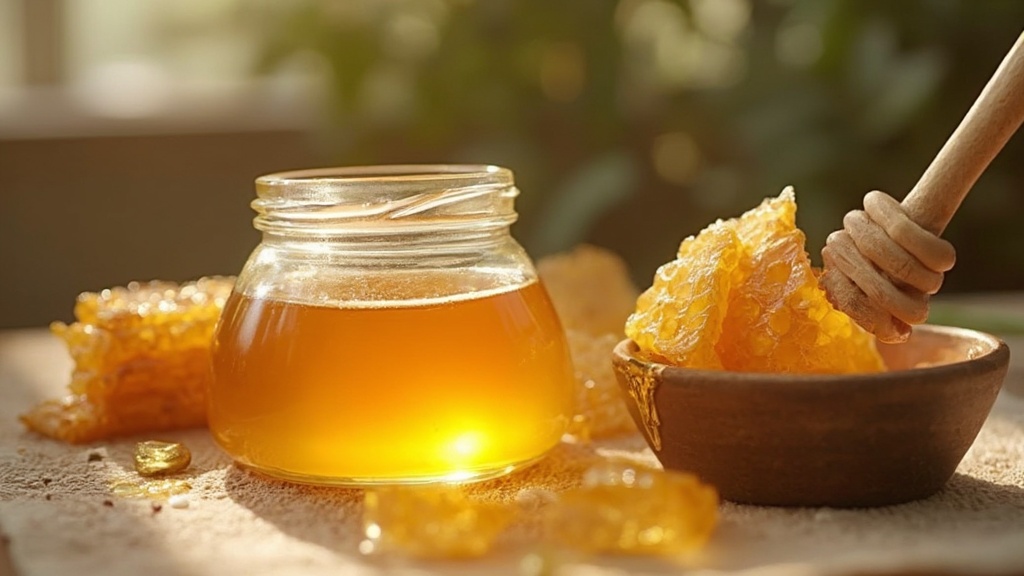
Creating a Honey Mask for Dry Skin
Time Required: 15-20 minutes
Materials Needed: Raw, organic honey
Honey is a natural humectant, meaning it attracts and retains moisture. It’s also packed with antioxidants and has antimicrobial properties, making it an excellent remedy for dry skin. Here’s how to use it:
- Start with clean, dry skin.
- Warm a tablespoon of raw honey between your palms.
- Apply a thin layer of honey to your face and neck, avoiding the eye area.
- Leave the honey mask on for 15-20 minutes.
- Rinse off with lukewarm water and pat your skin dry.
- Follow with your regular moisturizer if desired.
Benefits:
- Acts as a natural humectant, drawing moisture into the skin
- Contains antioxidants that protect skin from environmental damage
- Has antimicrobial properties that can help with acne-prone skin
- Promotes wound healing and may help with minor skin irritations
Research published in the Journal of Cosmetic Dermatology has shown that honey can significantly improve skin hydration and reduce water loss from the skin, making it an effective natural treatment for dry skin conditions.
Understanding the healing properties of natural substances like honey is a key aspect of naturopathic medicine. For those interested in exploring this field further, the Naturopathy Practitioner Training Course offers comprehensive education on natural healing methods, including the use of herbal and natural remedies for various health conditions, including skin health.
Conclusion
Dry skin can be a persistent and uncomfortable condition, but nature provides us with a wealth of remedies to address this common concern. From the soothing properties of aloe vera to the deep nourishment of shea butter, these eight herbal remedies offer natural, effective solutions for achieving healthy, hydrated skin.
By incorporating these natural remedies into your skincare routine, you can harness the power of nature to soothe, protect, and nourish your skin. Remember, consistency is key when using natural treatments, and it’s always important to patch test new remedies to ensure they work well with your skin.
For those interested in delving deeper into the world of natural healing and holistic health, exploring naturopathy can provide valuable insights into how these and other natural remedies can be used to promote overall well-being. The field of naturopathy offers a comprehensive approach to health that goes beyond just skincare, addressing the root causes of various health issues.
As you embark on your journey towards healthier skin, consider the broader implications of natural healing methods. The 7 reasons to become a naturopathic practitioner article offers insights into how this field can not only benefit your personal health but also open up new career opportunities in the growing field of natural medicine.
Remember, while these herbal remedies can be highly effective, it’s always important to consult with a healthcare professional, especially if you have persistent skin issues or underlying health conditions. By combining the wisdom of traditional remedies with modern scientific understanding, we can achieve optimal skin health naturally.
Explore More
- Integrating Naturopathy and Conventional Medicine
- Naturopathic Medicine in Women’s Health
- Getting Natural Relief from Pain Through Naturopathy
- Dispelling Myths: Naturopathy is Not Pseudoscience, It is Evidence-Based Healing
- Understanding Differences Between Naturopathy Practitioner and Naturopathic Doctor
References
- https://onlinelibrary.wiley.com/doi/10.1155/2019/5656925
- https://yourstory.com/herstory/2021/02/woman-entrepreneur-ayurveda-skincare-clean-beauty[1].
- https://www.mdpi.com/1999-4923/16/7/869
- https://medlineplus.gov/ency/patientinstructions/000751.htm
- https://pubmed.ncbi.nlm.nih.gov/12548256/
- https://www.herbalremediesadvice.org/calendula-benefits.html
- https://www.aad.org/public/diseases/eczema/childhood/itch-relief/home-remedies


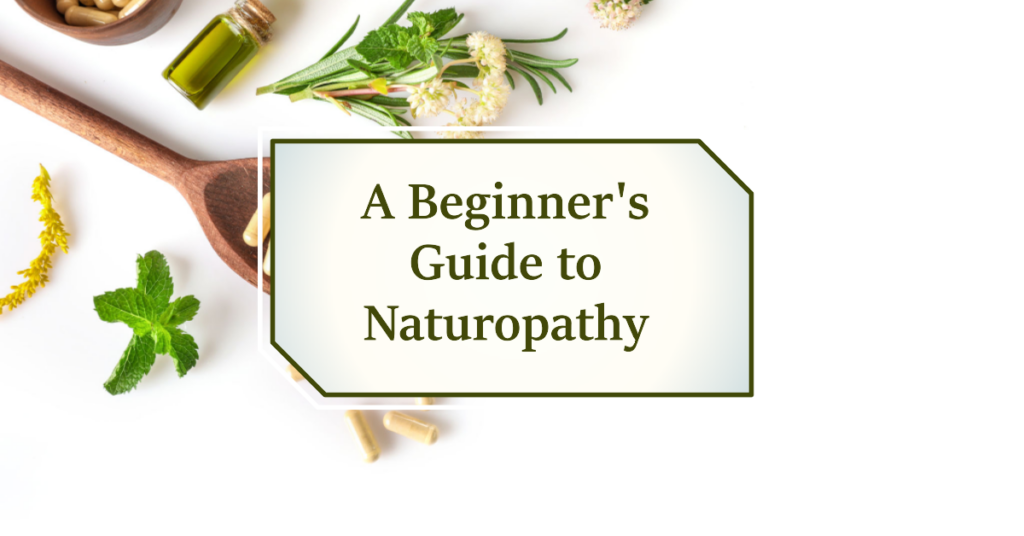







Responses